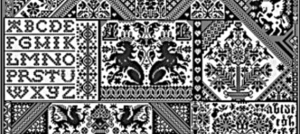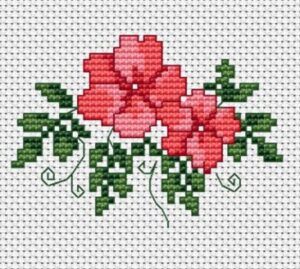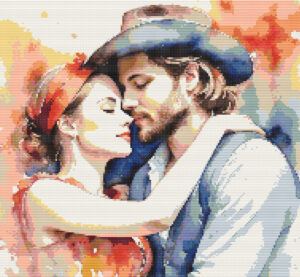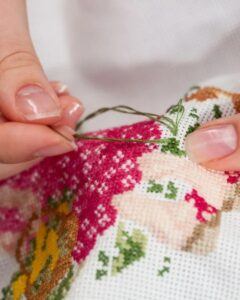
I stand in awe of cross-stitch embroidery, one of the earliest forms of handiwork known to us. The intricate X-shaped stitches lining ancient textile fragments whisper tales from a time long before industrial looms and digital patterns.
Archaeological digs have revealed the prevalence of cross-stitch patterns etched on the edges of dusty fabrics dating back to the 6th century. Experts suggest these origin points mark the intersection of creativity and necessity where people first used cross-stitching for both decorative and functional purposes.
Cross-stitch is unique. Unlike the freeform styles of other embroidery practices, it requires precision, aligning each stitch to create cohesive designs and patterns. It’s believed that earlier cross-stitch was simpler, utilizing natural fibers and dyes extracted from plants.
I appreciate subtle differences when comparing these ancient methods to contemporary cross-stitching. Differences range from the tools and materials used to the sophistication of designs. Still, the basic technique—the foundational cross—remains largely unchanged.
Integral to understanding cross-stitch is recognizing its evolution. As we step through time, we’ll see its rich contribution to domestic life in medieval Europe and its journey across cultures and eras.
Cross-Stitch Through the Ages: A Cultural Tapestry

Cross-stitch holds a special place in the chronicles of artistic expression. This form of needlework wasn’t merely a pastime; it played a key role in cultural and domestic settings. In medieval Europe, for instance, cross-stitch served as a symbol of refinement and education among the upper classes. It was a skill passed down through generations, often taught to young girls as part of their schooling in the domestic arts.
The spiritual realm also found the meticulous art of cross-stitch to be of great value. Numerous religious artifacts, ranging from church vestments to altar cloths, were adorned with intricate cross-stitching, reflecting the devotion and craftsmanship of the times. These pieces not only served as acts of worship but also as indicators of wealth and social status within the religious community.
Interestingly, cross-stitch patterns and techniques showed a remarkable diversity that can often be attributed to the historical trade routes. As goods and ideas traveled along the Silk Road and other trade pathways, so did the knowledge of cross-stitch. This led to an interchange of motifs and methods between cultures, enriching the tradition and leading to unique regional variations of the craft.
It’s this intricate interweaving of cross-stitch with the threads of history and society that sets the stage for the technique’s evolution. While the popularity of cross-stitch has ebbed and flowed over time, its cultural significance remains undeniable. Up next, you’ll see how cross-stitch weathered the storm of industrialization and re-emerged in the Victorian era to reestablish itself as not only a respected skill but as an avenue for creativity and personal expression.
The Renaissance of Cross-Stitch: From Decline to Popularity

In stark contrast to its former glory, cross-stitch faced a significant decline with the advent of the industrial revolution. This era introduced mass-produced textiles, pushing handmade crafts to the sidelines. The skills and patience required for cross-stitch no longer aligned with the fast-paced innovations of the time.
However, the story doesn’t end there. Fast forward to the Victorian era, and we witness a resurgence of interest in cross-stitch. The invention of pattern books during this time played a pivotal role. They served not only as guides but also as inspiration, reviving cross-stitch as a fashionable activity among the genteel, particularly in England. It was during this period that cross-stitch began to be associated with moral virtue, patience, and decorum.
Cross-stitch’s popularity didn’t wane with the Victorians. The 20th century saw various waves of resurgence, particularly during times when society yearned for a nostalgic return to traditional values. Its most recent uptick in popularity can largely be attributed to the rise of do-it-yourself (DIY) culture. Crafts resonated as a means to personalize living spaces and gifts, as well as an avenue for self-expression and mindfulness.
Today, cross-stitch is more than just a pastime. It serves as a bridge between the past and present, often featuring modern themes and contemporary design elements. This form of art continues to adapt, proving its resilience and unending appeal across generations.
Stitching Together the Future: Innovations and Community

Cross-stitch owes its enduring charm to the unique blend of tradition and innovation. While it’s deeply rooted in history, it continually evolves, integrating new ideas and technologies. In the realm of cross-stitch, today’s stitchers have more resources at their fingertips than ever before.
The advent of digital tools has been a game changer, providing enthusiasts with a platform to design, share, and personalize patterns. Software that converts images to stitchable patterns is especially popular, bridging the gap between traditional art and modern technology.
Moreover, the rise of social media has done wonders for the cross-stitch community. Platforms like Instagram, Pinterest, and dedicated forums breathe life into the craft, allowing stitchers to display their work, exchange tips, and find inspiration. This global network also acts as a springboard for emerging artists and designers who bring fresh perspectives to the world of cross-stitch.
In looking at current trends, we see a refreshing sense of humor and contemporary sensibility making its way into designs. Pop culture references, subversive themes, and personalized projects are just a few examples of how modern stitchers are making this age-old craft their own.
As we continue to welcome new tools and ideas, the cross-stitch community grows stronger and more diverse. It’s not just about preserving a historical technique; it’s about creating a space where people can connect, create, and express themselves one stitch at a time.
Happy Stitching


I’m intrigued by the historical depth and cultural significance of cross-stitch as presented in your article. I have a couple of questions that could further enhance our understanding:
1. Beyond medieval Europe, in which other regions or cultures around the world were cross-stitched particularly popular, and how did their techniques or styles differ?
2. How have the materials and tools used in cross-stitch changed over the centuries, and what impact has this had on the art form?
Your insights into these areas would greatly enrich our appreciation of cross-stitch’s global and historical tapestry. Thank you for such an informative piece!
Sincerely,
Steve
Steve, history of any magnitude has always interested me as it obviously does you. While cross-stitch, or techniques resembling it, have been found in various cultures worldwide, here are two prominent examples beyond medieval Europe:
1. China:
Rich History: Embroidery flourished in China, particularly during the Tang Dynasty (618-906 AD). While not strictly cross-stitch, techniques like “Shu embroidery” used counted threads and geometric patterns, creating intricate and detailed designs.Symbolic Meanings: Chinese embroidery often incorporated symbolic motifs like dragons, phoenixes, and flowers, representing power, prosperity, and longevity.Materials and Techniques: Silk thread and fine needles were commonly used, and stitches like satin stitch and long-and-short stitch were employed to create textured and layered effects.
2. South America:
Pre-Columbian Era: Evidence of cross-stitch-like techniques exists in textiles from pre-Columbian cultures like the Nazca and Moche civilizations in Peru. These embroideries often depicted geometric shapes, animals, and deities, holding cultural and religious significance.Diverse Techniques: Various regions developed unique styles. For example, the Mapuche people of Chile used wool yarn and incorporated intricate geometric patterns and symbolic imagery into their weavings.Vibrant Colors: Natural dyes were used to create vibrant colors like red, yellow, blue, and green, reflecting the rich cultural and artistic heritage of the region.
These are just two examples, and the history of cross-stitch and related embroidery techniques is vast and diverse. Other notable regions with their own unique styles include:
Egypt: Hieroglyphs and geometric patterns were stitched onto clothing and funerary cloths.Palestine: Cross-stitch was used to decorate clothing and household items, often featuring geometric patterns and floral motifs.Eastern Europe: Countries like Russia and Ukraine have a rich tradition of embroidery using colorful threads and depicting folk motifs and religious scenes.
It’s important to note that cultural exchange and trade routes have influenced the development of cross-stitch techniques and styles throughout history. This cross-pollination continues today, with stitchers worldwide drawing inspiration from various cultures and incorporating them into their own practices.
And with regard to the material and tools and how their evolutions have changed, they obviously have undergone significant changes, impacting the art form in various ways:
Early Materials and Tools:
Pre-Industrial Revolution: Natural fibers like wool, linen, and silk were the primary options for thread, often hand-spun and dyed with natural elements. Fabrics were handwoven from these fibers, leading to variations in weave and texture. Needles were handcrafted from bone, wood, or metal, with limited size and shape options.Limitations: These materials presented challenges. Wool could be coarse and scratchy, while linen lacked the sheen of silk. Handwoven fabric offered limited uniformity, and crude needles could damage delicate threads.Impact: Despite limitations, early stitchers achieved remarkable detail and artistic expression using these materials. The imperfections often added a unique character and charm to the finished pieces.
Modern Materials and Tools:
Industrial Revolution Onwards: The Industrial Revolution brought advancements like mass production of threads and fabrics. Cotton thread, readily available and affordable, became popular. Aida cloth, a specially woven fabric with evenly spaced holes, emerged, simplifying the counting process. Steel needles, available in various sizes and thicknesses, offered greater precision and prevented damage to threads.Greater Accessibility and Ease: These advancements made cross-stitch more accessible to a wider audience. Standardized materials ensured consistent results, and easier stitching techniques encouraged experimentation and creativity.Wider Range of Designs and Techniques: With readily available materials and fabrics, the range of possible designs and techniques expanded significantly. Stitchers could explore intricate patterns, complex color palettes, and diverse styles with greater confidence.
Additional Impacts:
Standardization: While advancements made the art form more accessible, some argue that they also led to a certain degree of standardization, potentially limiting creative expression for some.Sustainability Concerns: The mass production of synthetic materials raises concerns about environmental impact and sustainability. Stitchers are increasingly turning to eco-friendly alternatives like organic cotton and recycled materials.Technological Integration: The rise of digital patterns and online communities has further revolutionized the art form, offering diverse design options, fostering collaboration and learning, and making cross-stitch even more accessible in the digital age.
In conclusion, the evolution of materials and tools in cross-stitch has had a profound impact on the art form. It has increased accessibility, broadened creative possibilities, and propelled the art form into the modern age. However, it’s important to acknowledge the potential drawbacks of standardization and environmental concerns, encouraging mindful material choices and responsible practices to ensure the sustainability and continued growth of this rich artistic tradition.